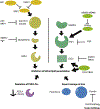Emerging Mechanisms and Disease Relevance of Ferroptosis
- PMID: 32413317
- PMCID: PMC7230071
- DOI: 10.1016/j.tcb.2020.02.009
Emerging Mechanisms and Disease Relevance of Ferroptosis
Abstract
Cell death is an essential feature of development in multicellular organisms, a critical driver of degenerative diseases, and can be harnessed for treating some cancers. Understanding the mechanisms governing cell death is critical for addressing its role in disease. Similarly, metabolism is essential for normal energy and biomolecule production, and goes awry in many diseases. Metabolism and cell death are tightly linked in the phenomenon of ferroptosis, a form of regulated cell death driven by peroxidation of phospholipids. Glutathione peroxidase 4 (GPX4) uses glutathione to protect cells from ferroptosis by eliminating phospholipid peroxides. Recent data have revealed glutathione/GPX4-independent axes for suppressing ferroptosis, and insight into the regulation of iron and mitochondria in ferroptosis. Ferroptosis has recently been implicated in multiple diseases, and functions as a tumor suppression mechanism. Ferroptosis induction is a promising approach in treating several conditions, including neoplastic diseases. Here, we summarize these recent advances.
Keywords: ferroptosis; iron; lipid peroxidation; metabolism; ubiquinone, cancer.
Copyright © 2020 Elsevier Ltd. All rights reserved.
Figures



References
-
- Dolma S et al. (2003) Identification of genotype-selective antitumor agents using synthetic lethal chemical screening in engineered human tumor cells. Cancer Cell 3 (3), 285–96. - PubMed
Publication types
MeSH terms
Substances
Grants and funding
LinkOut - more resources
Full Text Sources

